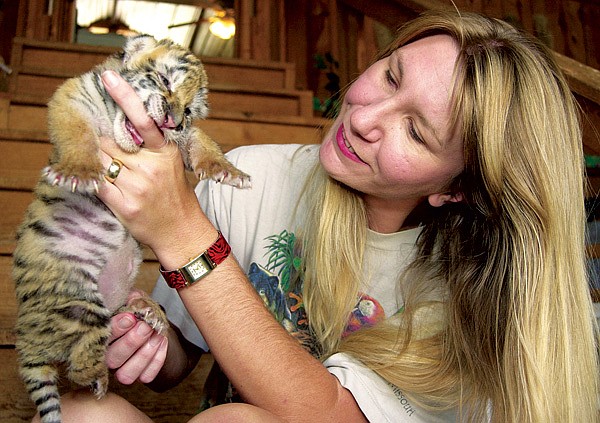Turpentine Creek ‘Ambushed’
Influx of tigers marks 20th anniversary of refuge
Tanya Smith, one of the founders of Turpentine Creek Wildlife Refuge near Eureka Springs, greets a new arrival.
Friday, December 21, 2012
LITTLE ROCK — For Tanya Smith, the tagline for 2012 might be “guess who’s coming to dinner.” Since Turpentine Creek Wildlife Refuge opened 20 years ago near Eureka Springs, voraciously hungry new residents have turned up regularly. But 2012 was the first time they came in an “ambush” although that describes both a group of tigers and the situation of six tigers and one cougar arriving at the refuge at the time
Turpentine Creek was founded by Tanya Smith and her parents in 1992, prompted by three cattle trailers full of lions and tigers - 42 of them - showing up on the family’s doorstep.
“We sold everything we had and bought this piece of property we’d been looking at for about 15 years,” Smith remembers. “We did everything we could to save those animals.”
At the beginning of 2012, the wildlife refuge was celebrating 20 years in operation by opening new habitats that offered a better quality of life for 115 big cats, seven black bears, a grizzly bear and what Smith lovingly calls “a variety” of other rescued animals.
“Our goal is to get them all out where they can run and play, sleep under a shade tree if they want to or swim in a pool,” she said earlier this year.
The work Smith inherited has never been easy. Feeding the resident population takes roughly 1,200-1,500 pounds of raw meat a day in the winter and about 800 pounds a day in the summer. Tyson Foods, Zero Mountain, Walmart and Don’s Cold Storage are among businesses that donate - “and if someone loses a cow and they can get it to us quickly, then we can recycle that meat and feed it to the bigcats,” she says.
Then Smith and her team were called to help a private sanctuary near Mountainburg relocate some of its 34 big cats. Betty Young, 72, the owner of Riverglen Tiger Shelter, had health problems and needed solutions - and she needed them right away.
“The media has helped to get the word out about the situation,” Smith says.
“Through that and Facebook, we have been able raise about $84,000 to date,” enough to adopt seven animals. “But to bring in all the cats, it will cost $238,000 to build all the facilities we will need and bring in more housing to hire more interns to help us maintain the workload of feeding, cleaning and general care that the added influx of animals will require.
“Each tiger at the RTS facility lives alone, so we will need a cage for each one,” Smith adds. “We will continue tobuild as donations come in.”
As of Dec. 13, Bill Bowden reported in the Arkansas Democrat-Gazette, two black leopards had been adopted by a conservatory in Kansas, and Turpentine Creek has its eye on 10 more tigers.
Young wants to keep about 10 cats at Riverglen.
Smith is determined to see all of the cats that need homes get homes. She’s already in love with the Riverglen tigers she’s adopted.
“They are all very special to me,” she says. “Duckie is a blind tiger that we brought in, and she is so sweet despite her problems.
“Also Chopper was the first tiger we took for RTS. She is a beautiful white tiger that had a grapefruit-sized tumor on her side. It was open and bleeding, so she immediately went to our veterinarian, Dr. Ron Eby in GreenForest, to have the tumor removed. She is doing great now, (although) she is an older tiger and the tumor did come back cancerous. That is common in older tigers and big cats. Chopper will be monitored and as long as she looks good and doesn’t seem in pain, then she will be allowed to live out the remainder of her life with love and dignity.”
Smith says although “rescue is our first priority,” the Turpentine Creek staff has “big plans for the future.
“The area we are developing for the Riverglen Tiger Shelter cats is going to morph into an off-exhibit quarantine area. We need to build a veterinarian clinic on site to accommodate the large predators we care for daily. We are building 20-by-50-foot cages that we can add on exercise yards later.
“At this time, we just want to save their lives.”
Whats Up, Pages 14 on 12/21/2012
